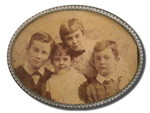



Provenance
3 - Samuel Bruce McLaren
3 - Samuel Bruce McLaren
|
Home Provenance Series List Search |
| Date Range | 1876 - 1916 |
| Details When S. B. McLaren was killed in World War One, the prevailing sentiment was not only of great sadness but what could have been. His educational achievements and impressive but all too brief career were constantly punctuated by remarks about his "great originality" and future eminence. Posthumously compared to Einstien, Jeans, Planck, Laue and Abraham, McLaren’s research on the theory of radiation was considered both unique and exciting. Born on 16 August 1876 at Yedo in Japan, Samuel Bruce McLaren moved to Melbourne with his parents at the age of five. Instilled with a passion for learning and truth, Bruce McLaren was educated at Coburg State School, Brighton Grammar and Scotch College and at the University of Melbourne. He graduated in 1897 with first class honours in mathematics and was awarded the Wyselaskie Scholarship in mathematics and the Dixon Scolarship in natural philosophy. After a brief respite in Australia, McLaren returned to England in 1904. He was appointed lecturer in mathematics at University College, Bristol and subsequently transferred to Birmingham University two years later. The constant letters home are testament to McLarens’s homesickness but the decision to live in England allowed him access to an privileged environment to observe the immense developments in mathematical physics which challenged his own fundamental ideas and to befriend a fascinating milieu of intellectuals on the fringes of the Bloomsbury set. Although McLaren enjoyed these advantages he remained ambivalent about England and highly critical of its repressive class system. In June 1914, McLaren returned to Australia for the meeting of the British Association of the Advancement of Science. It would prove a bittersweet homecoming as the outbreak of the first World War was announced and McLaren anguished over his decision to join up. Although courageous and possessing an infinite belief in duty, Bruce McLaren was deeply opposed to violence and was never attracted to military life. Nevertheless he resolved to join up and began to study signalling aboard ship. During the trip back to England, McLaren received the distressing news of his father’s death. Serving as a Lieutenant with the Royal Engineers, McLaren fearlessness inspired feelings of idolatry amongst his men. Sadly the great potential and expectations for McLaren’s life did not eventuate. In August 1916 at Briquetterie, he was badly wounded in the head when he and two volunteers went out to clear a store of bombs out of a burning ammunition dump. McLaren returned alone to complete the task and was wounded again and died two weeks later. With the exception of his scientific papers that were compiled and printed posthumously, the war precluded McLaren from publishing his work on the fundamental problems of mathematical physics that had enthralled him since Cambridge. J. Nicholson later contended that the premature deaths of both McLaren and Moseley were perhaps the two most irreparable losses to the future of science caused by the war. | |
| References | Australian Dictionary of Biography; Conversation with Marjory Miller, 1999 and 2000. |
| Series | 13 Samuel Bruce McLaren - Correspondence 1897 - 1925 14 Samuel Bruce McLaren - Service Papers and Death Notices 1916 - 1928 15 Samuel Bruce McLaren - Publications 1911 - 1928 16 Samuel Bruce McLaren - Personal Papers 1884 - 1916 |
|
Published by the The University of Melbourne eScholarship Research Centre, May 2008
With support from Mrs Marjory Miller Listed by Fay Anderson and Gavan McCarthy HTML edition Rachel Tropea Updated 2 April 2009 http://www.austehc.unimelb.edu.au/guides/mcla/MCLAP03.htm The template for this finding aid is part of the Heritage Documentation Management System |
[ Top of Page | Home | Series | Provenance | Search ] |